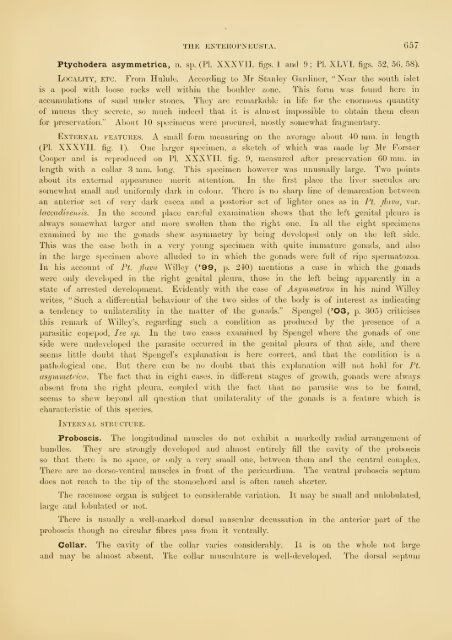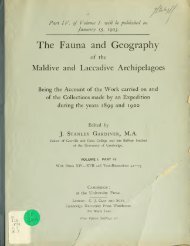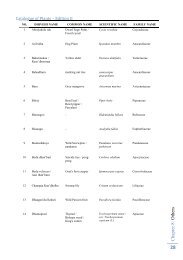Download - WordPress – www.wordpress.com
Download - WordPress – www.wordpress.com
Download - WordPress – www.wordpress.com
Create successful ePaper yourself
Turn your PDF publications into a flip-book with our unique Google optimized e-Paper software.
THE ENTEROPNEUSTA. 657Ptychodera asymmetrica, n. sp. (PL XXXVII. figs. 1 and 9; PI. XLVI. figs. 52, 56, 58).Locality, etc. From Hulule. According to Mr Stanley Gardiner, " Near the south isletis a pool with loose rocks well within the boulder zone. This form was found here inaccumulations of sand under stones. They are remarkable in life for the enormous quantityof mucus they secrete, so much indeed that it is almost impossible to obtain them cleanfor preservation." About 10 specimens were procured, mostly somewhat fragmentary.External features. A small form measuring on the average about 40 mm. in length(PL XXXVII. fig. 1). One larger specimen, a sketch of which was made by Mr ForsterCooper and is reproduced on PL XXXVII. fig. 9, measured after preservation 60 mm. inlength with a collar 3 mm. long. This specimen however was unusually large. Two pointsabout its external appearance merit attention. In the first place the liver saccules aresomewhat small and uniformly dark in colour. There is no sharp line of demarcation betweenan anterior set of very dark caeca and a posterior set of lighter ones as in Pt. Jiava, var.laccadivensis. In the second place careful examination shews that the left genital pleura isalways somewhat larger and more swollen than the right one. In all the eight specimensexamined by me the gonads shew asymmetry by being developed only on the left side.This was the case both in a very young specimen with quite immature gonads, and alsoin the large specimen above alluded to in which the gonads were full of ripe spermatozoa.In his account of Pt. flava Willey ('99, p. 240) mentions a case in which the gonadswere only developed in the right genital pleura, those in the left being apparently in astate of an-ested development. Evidently with the case of Asyminetron in his mind Willeywrites, " Such a differential behaviour of the two sides of the body is of interest as indicatinga tendency to unilaterality in the matter of the gonads." Spengel ('03, p. 305) criticisesthis remark of Willey's, regarding such a condition as produced by the presence of aparasitic copepod, Ive sp. In the two cases examined by Spengel where the gonads of oneside were undeveloped the parasite occurred in the genital pleura of that side, and thereseems little doubt that Spengel's explanation is here correct, and that the condition is apathological one. But there can be no doubt that this explanation will not hold for Pt.asymmetrica. The fact that in eight cases, in different stages of growth, gonads were alwaysabsent from the right pleura, coupled with tlie fact that no parasite was to be found,seems to shew beyond all question that unilaterality of the gonads is a feature which ischaracteristic of this species.Internal structure.Proboscis. The longitudinal muscles do not exhibit a markedly radial arrangement ofbundles. They are strongly developed and almost entirely fill the cavity of the proboscisso that there is no space, or only a very small one, between them and the central <strong>com</strong>plex.There are no dorso- ventral muscles in front of the pericardium. The ventral proboscis sepituradoes not reach to the tip of the stomochord and is often much shorter.The racemose organ is subject to considerable variation. It may be small and unlobulated,large and lobulated or not.There is usually a well-marked dorsal muscular decussation in the anterior part of theproboscis though no circular fibres pass from it ventrally.Collar. The cavity of the collar varies considerably. It is on the whole not largeand may be almost absent. The collar musculature is well-developed. The dorsal septum






